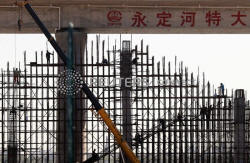China June new loans seen at 5-month high as central bank keeps
liquidity ample: Reuters poll
 Send a link to a friend
Send a link to a friend
 [July 08, 2019] BEIJING
(Reuters) - New bank loans in China are expected to have picked up to a
five-month high in June, a Reuters poll showed, as Beijing kept ample
liquidity in the financial system to support the slowing economy and
offset growing U.S. trade pressure. [July 08, 2019] BEIJING
(Reuters) - New bank loans in China are expected to have picked up to a
five-month high in June, a Reuters poll showed, as Beijing kept ample
liquidity in the financial system to support the slowing economy and
offset growing U.S. trade pressure.
The central bank also stepped up cash injections last month to calm
nerves after regulators seized a troubled regional bank, which sparked
worries of financial contagion and briefly drove some short-term lending
rates to record highs.
Chinese banks likely extended 1.7 trillion yuan ($246.92 billion) in net
new yuan loans last month, up from 1.18 trillion in May but below 1.84
trillion in June 2018, according to a median estimate in a Reuters
survey of 29 economists.

But some analysts are bracing for a weaker reading, after data from the
China Banking and Insurance Regulatory Commission (CBIRC) last week
suggested lenders doled out more than 990 billion in new loans last
month.
"We expect a modest rise in new loans due to seasonal factors," said
Tang Jianwei, a senior economist at Bank of Communications in Shanghai.
"But CBIRC's H1 data suggested new loans in June might be slightly lower
than May. We think this is due to weak loan demand from the real
economy, as investment and consumption remain sluggish and exports still
faces downward pressure."
Banks might also have been more cautious about lending risks in the wake
of the takeover of Baoshang Bank in May, Tang added.
Capital Economics forecasts June loans at 1 trillion yuan, while noting
that a slowdown may have been offset by faster growth in other forms of
credit.
A steady stream of downbeat economic data in recent months has raised
expectations that more policy easing is needed in China to put a floor
under cooling growth. But top officials have repeatedly tried to
downplay the likelihood of aggressive stimulus measures.
A central bank adviser said last week that China will not need "very
big" stimulus to prop up growth, provided its trade dispute with the
United States does not worsen. The two sides agreed to a trade ceasefire
last month while they resume talks, but existing tariffs remain in
place, threatening a continued "slow burn" for the Chinese economy,
according to ING.
[to top of second column] |

Workmen stand on scaffolding underneath a railway bridge located on
the outskirts of Beijing September 13, 2012. REUTERS/David Gray

The poll also showed that outstanding yuan loan growth on a year-on-year basis
likely held steady at 13.4% from May, while broad M2 money supply was seen
rising fractionally to 8.6% on-year, from 8.5%.
TSF, a broad measure of credit and liquidity in the economy, was estimated to
have risen to 1.95 trillion yuan in June from 1.4 trillion in May.
TSF includes off-balance sheet forms of financing that exist outside the
conventional bank lending system, such as initial public offerings, loans from
trust companies and bond sales.
Corporate bond issuance appears to have picked up last month in response to
falling market interest rates, Capital Economics said in a note.
China's benchmark overnight repo rate fell to a four-year low of nearly 1% in
late June as the central bank poured funds into money markets ahead of a
seasonal surge in cash demand at the end of June.
Seasonal worries over tight liquidity intensified after the government's
takeover of debt-laden Inner Mongolia-based Baoshang Bank [BAOTO.UL], which also
added to concerns over the risk of mounting bad loans.
While regulators said Baoshang was an isolated case, some smaller banks and
brokers have since struggled to get short-term funding and their financing costs
have spiked, prompting regulators to warn larger lenders not to cut off firms
from market funding.
(Reporting by Lusha Zhang and Kevin Yao; Editing by Kim Coghill)
[© 2019 Thomson Reuters. All rights
reserved.] Copyright 2019 Reuters. All rights reserved. This material may not be published,
broadcast, rewritten or redistributed.
Thompson Reuters is solely responsible for this content.
 |